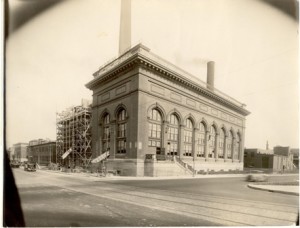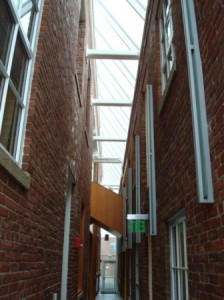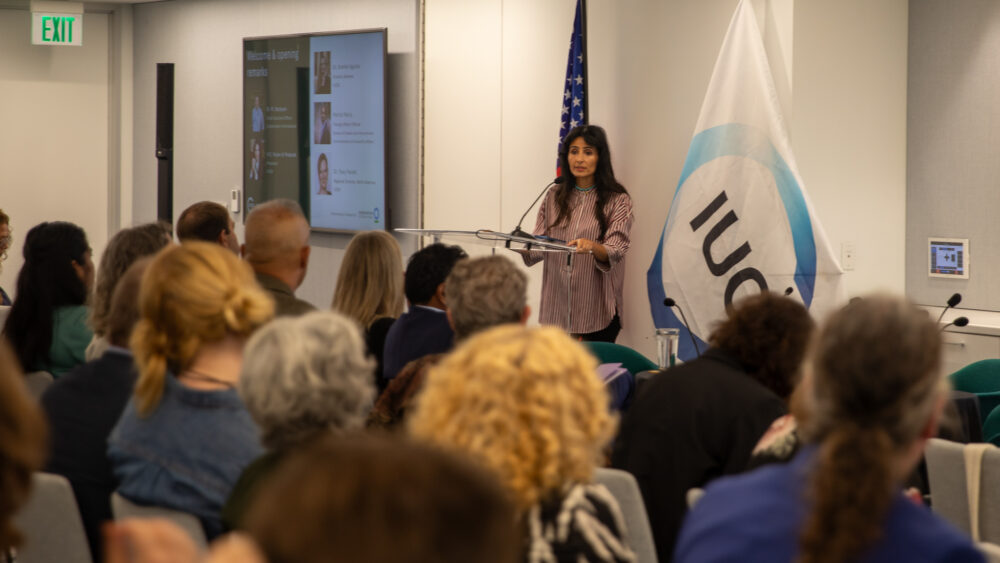We have much more to do and your continued support is needed now more than ever.
Balancing Nostalgia with Efficiency

From the get-go, HUOS set high green goals for the 40,000 square foot brownfield reclamation project that combined three adjacent structures built between 1889 and 1926, one of which had functioned as a Cambridge Electric Light Company coal switching house.
The biggest challenge was improving the energy efficiency of the draft-prone nature of the building’s heavy masonry structure, a common hurdle for buildings of this age. Heating typically accounts for a much larger energy investment than cooling, and this is certainly true for buildings like the Blackstone in cooler areas of the country. However, since Harvard is able to produce and distribute their own cheap steam heat (powered by oil and natural gas and distributed through underground tunnels), the team would focus on overall building efficiency and low-energy cooling and air circulation requirements.
Brickwork is notorious for its tendency to allow heat to pass through it freely. But as one of the building’s most attractive qualities, the designers were hesitant to cover it over altogether. Working closely with the Cambridge Historical Commission, the team eventually came to a compromise. Most of the interior brickwork would be finished with Icynene spray foam insulation and then finished with sheetrock. The insulation is an open cell foam tested to allow the free-flow of water vapor while blocking the passage of air and liquid water. This is important since, were the insulation to trap moisture against winter-cooled brickwork, the moisture would freeze, tearing the brick apart.
“It’s a really delicate matter,” according to Henry Moss, one of three Bruner/Cott principals on the design team. “In a way it’s all very low-tech, but people have been unable to do this in the past.”

Once the air leaks were addressed, it was time to think about how to cool the space. Two standing column geothermal wells remove heat from the building through a heat rejection process. Generally much deeper than closed loop wells, in this case 1,500 feet deep each, the vertical installation of standing column wells (SCW) makes them ideally suited for areas where land is at a premium. Their installation is also cheaper than closed loop systems.
SCWs remove heat by pumping cool water from the bottom of the well and re-injecting warm water at the top. At the Blackstone building, hydronic valance units installed near the ceiling circulate the cool well water. As the room temperature raises the temperature of the water, it circulates back to the wells to be cooled again. This system, which requires less energy than using electricity to run an air conditioner, has a significant positive effect on the building’s carbon dioxide emissions. Eastern Connecticut State University installed a similar system in their high-rise residence hall that cuts heating and cooling costs by 80 percent and provides domestic hot water, too.
Further savings for both the heating and cooling systems are obtained through a zero-energy air circulation system. Forcing air through a building via fans and pumps often accounts for 20 percent of the total electricity use. The Blackstone system relies instead on free, clean, natural convection: a hydronic valance system has the added benefit of fewer visible ducts and less rooftop and ground-level equipment, which are easier to coordinate with the look of exposed beams and ceiling decks in historic industrial space. A hydronic heating system can also be found on the California College of the Arts (San Francisco) campus in a retrofitted 1950s Greyhound Bus building.
| Not Just About Energy:
Known by the community for over 100 years as a coal switching house, the project had some serious soil contamination challenges. Moving the soil proved too expensive, but none of the neighbors wanted toxins leeching into the nearby the Charles River. The team therefore mounted a complex excavation project, carefully mounding the soil where it wouldn’t cause problems, covering it with soil and plants. A bioswale was also created to filter storm water entering the river. |
To complete the picture, the building was installed with operable, low-e glass, double-hung, argon-filled aluminum windows that preserve the look of the building in their old-world design and act as an ultra-efficient and functional “first line” of cooling. Working from two originals, the team matched the profiles, then designed the easy-to-operate awning window to look like a double-hung sliding sash.
This old building appears to have attained a significant energy-saving boost through the retrofitting project, but there have been a few hiccups along the way, and efficiencies are likely to be less than those achieved by building new, even with embodied energy taken into consideration.
“I think it is harder to reach the same performance levels as new construction when we adapt historic structures,” suggests Moss. “It is generally much more difficult to integrate new building systems into historic interiors in a visually satisfactory way, but their operation can still be quite sophisticated.”
Buildings similar to the Blackstone typically have heating and cooling ratios around 70-30, and although data on Blackstone’s performance has not yet been published, the team anticipates the building’s envelope and systems designs to result in a 40 percent decrease in overall energy consumption.
Yet sometimes systems don’t perform as well as expected. The efficacy of the geothermal system, for instance, was less than anticipated due to the narrow temperature differential between warmed water from the valance system and cooler groundwater as temperatures increase during summer. Combined with the comparable operating costs between this system and conventional cooling towers or split-system air conditioners, some might view the zero-carbon cooling system’s price too high.
Was it worth it? According to Moss, if you’re not in it for the long haul, it may not be. “The paybacks are not short term. That is why this kind of building makes so much sense for institutions that will continue to own, maintain, and operate their buildings.
See More:
History in the Making: University Business
Vassar’s Historic Observatory Gets $3.9 Million Makeover: Buildings & Grounds





















